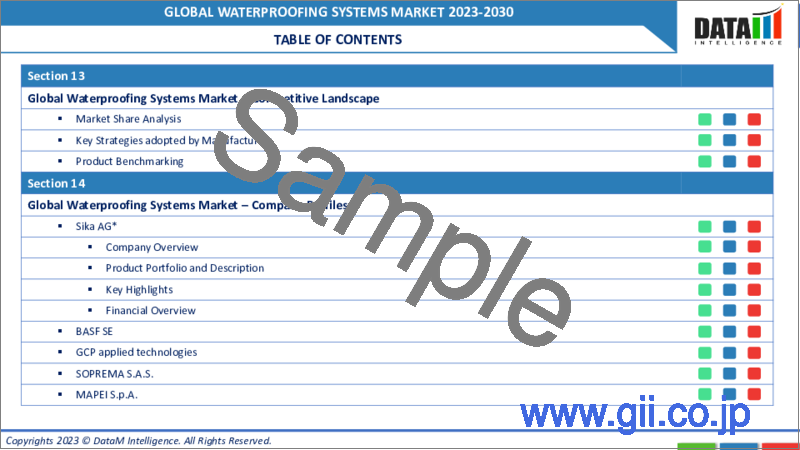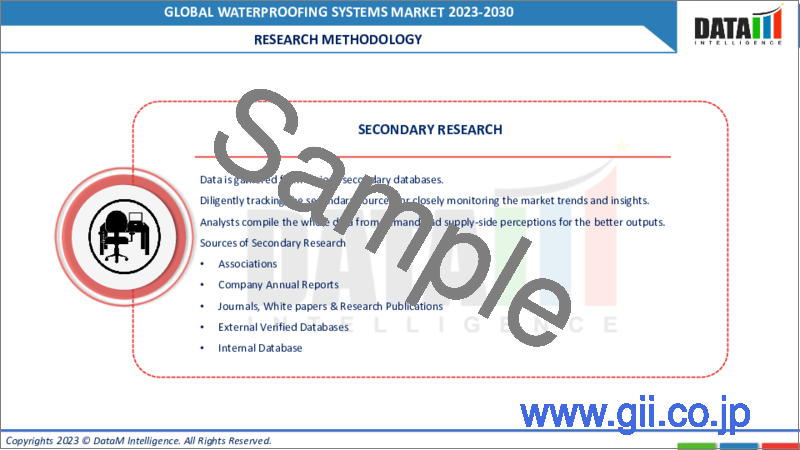|
|
市場調査レポート
商品コード
1336745
防水システムの世界市場-2023年~2030年Global Waterproofing Systems Market - 2023-2030 |
||||||
カスタマイズ可能
適宜更新あり
|
|||||||
| 防水システムの世界市場-2023年~2030年 |
|
出版日: 2023年08月22日
発行: DataM Intelligence
ページ情報: 英文 181 Pages
納期: 即日から翌営業日
|
- 全表示
- 概要
- 目次
市場概要
防水システムの世界市場は、2022年に638億米ドルに達し、2023-2030年の予測期間中にCAGR 6.7%で成長し、2030年には1,066億米ドルに達すると予測されています。
センサーとモノのインターネット(IoT)機能を備えたスマート防水システムの台頭により、水の浸入をリアルタイムで監視できるようになっています。世界の建設セクターの継続的な拡大は、防水システム市場の主要な促進要因となっています。住宅と商業施設の建設プロジェクトでは、水の浸入や漏水、湿気関連の問題から保護するために効果的な防水工事が必要です。建設活動の増加に伴い、信頼性の高い高度な防水技術に対する需要も増加しています。
建築構造物分野は市場の3分の2以上のシェアを占めており、建築構造物を水の浸入から保護する要求が高まった結果、防水システムは世界中で頻繁に使用されるようになっています。より耐久性が高く、環境に優しい防水ソリューションを提供するための研究開発が活発化した結果、建築構造物をカビから保護する防水システムのニーズが高まっています。
市場力学
拡大する水・廃棄物管理産業
水管理には、巨大な貯水槽、下水道、処理槽、放水路、運河、流入口、水処理施設、廃水処理用ユーティリティの防水などの作業が含まれます。これらの用途では、PU、エポキシ、セメント系、結晶系のメンブレンシステムなどの防水材料が使用されます。
上下水道処理施設では、前処理槽、一次沈殿槽、二次沈殿槽、生物処理槽、汚泥槽、三次処理槽、均圧槽、運転施設、その他の槽や構造物に防水処理が施されています。早期の損傷を防ぎ、長い耐用年数を実現するためには、これらの機器や設備に適切な防水処理を施す必要があります。防水システム市場が急拡大している背景には、都市化と工業化による水管理需要があります。
建設産業への投資の増加
急速な都市化と新興諸国における建設産業の拡大により、防水システムの需要は予測期間を通じて増加すると予想されます。防水システムの需要は、特に多くの新興国の消費者における消費力の向上と生活水準の上昇の結果として高まっており、建物や財産の完全性の維持・保護に役立っています。防水材は屋内でも屋外でも使用できるため、柔軟性が高く、コスト面でも有利です。
このような利点に加え、こうしたシステムの利用に対するニーズも高まっています。国連の推計によると、2030年から2050年にかけて、世界の人口はそれぞれ85億人と97億人に増加し、住宅、商業施設、高速道路、廃棄物・水管理インフラの増設が必要となります。
中国、ブラジル、インド、東南アジア、ロシア、その他の成長国では、インフラ整備と改善の余地が大きいです。これらの膜はインフラ全般の品質向上と長寿命化に不可欠であるため、防水システムの消費は増加すると予想されます。
原材料価格の上昇
防水システムの生産に必要な原材料の価格変動と不足は、業界の成長を妨げると予想されます。原材料費の高騰が防水システムの製造コスト全体を押し上げ、需要を減少させる可能性があります。需要の増加と供給のギャップは、世界の防水システム市場の成長を抑制すると予想されるその他の要因です。
中国塗料工業協会によると、2022年初頭、防水材の主原料コストは年々大幅に上昇しており、アスファルトやエマルジョンなどの製品はいずれも30%以上の成長率を示しています。さらに、コーティング業界の大半の企業は、急激なコスト上昇の結果、赤字が続いています。
COVID-19影響分析
COVID-19の大流行は、製造施設の閉鎖、需要の落ち込み、サプライチェーンの混乱などの結果、多くの国々で経済成長を阻害しています。防水システムを利用し、COVID-19によって悪影響を受ける最も重要な分野は、建築・建設業界です。
パンデミックによって住宅や商業施設の建設が中断しています。このセクターは、サプライチェーンの混乱、物流の課題、労働者の使用不能、部品の入手制限、企業の資金繰りの悪化、需要の減少、多くの国々でのロックアウトによる製造停止によって損害を被っています。
目次
第1章 調査手法と調査範囲
第2章 定義と概要
第3章 エグゼクティブサマリー
第4章 市場力学
- 影響要因
- 促進要因
- 建設産業への投資増加
- 水・廃棄物管理産業の拡大
- 抑制要因
- 原材料価格の上昇
- 機会
- 持続可能な防水システムとグリーンビルディングの革新
- 影響分析
- 促進要因
第5章 産業分析
- ポーターのファイブフォース分析
- サプライチェーン分析
- 価格分析
- 規制分析
第6章 COVID-19分析
第7章 タイプ別
- 防水膜
- 防水ケミカル
- 一体型システム
第8章 材料別
- ポリウレタン
- セメント系塗料
- EPDMゴム
- ゴム引きアスファルト
- 熱可塑性プラスチック
- その他
第9章 工法別
- 噴霧
- 射出
- ライニング
- 硬質
- 塗装可能
- プラスター
- その他
第10章 用途別
- 建築構造
- 屋根・壁
- 道路
- 廃棄物・水管理
- トンネル覆工
- 橋梁・高速道路
- その他
第11章 地域別
- 北米
- 地域別の主な動向
- 米国
- カナダ
- メキシコ
- 地域別の主な動向
- 欧州
- 地域別の主な動向
- ドイツ
- 英国
- フランス
- イタリア
- ロシア
- その他欧州
- 地域別の主な動向
- 南米
- 地域別の主な動向
- ブラジル
- アルゼンチン
- その他南米
- 地域別の主な動向
- アジア太平洋
- 地域別の主な動向
- 中国
- インド
- 日本
- オーストラリア
- その他アジア太平洋
- 地域別の主な動向
- 中東・アフリカ
- 地域別の主な動向
第12章 競合情勢
- 競合シナリオ
- 市況/シェア分析
- M&A分析
第13章 企業プロファイル
- BASF SE
- 会社概要
- 製品ポートフォリオと概要
- 財務概要
- 最近の動向
- Sika AG
- RPM International Inc
- GCP Applied Technologies Inc.
- Pidilite Industries Limited
- Carlisle Companies Inc
- DOW
- Kemper System America, Inc
- Mapei Corporation
- Henkel AG & Co. KGaA
第14章 付録
Market Overview
Global Waterproofing Systems Market reached US$ 63.8 billion in 2022 and is expected to reach US$ 106.6 billion by 2030, growing with a CAGR of 6.7% during the forecast period 2023-2030.
The rise of smart waterproofing systems equipped with sensors and Internet of Things (IoT) capabilities has enabled real-time monitoring of water ingress. The continuous expansion of the global construction sector has been a major driver for the waterproofing systems market. Both residential and commercial construction projects require effective waterproofing to safeguard against water seepage, leaks and moisture-related issues. As construction activities increase, so does the demand for reliable and advanced waterproofing technologies.
Building Structures segment holds more than 2/3rd share in the market and waterproofing systems are being used more often across the world as a result of increasing demands for protection building structures towards water penetration. The need for waterproofing systems that protect building structures from mold and mildew is growing as a consequence of increased research and development efforts to provide more durable and environmentally friendly waterproofing solutions.
Market Dynamics
Expanding Water and Waste Management Industry
Water management involves tasks such as waterproofing immense water tanks, sewers, treatment tanks, spillways, canals and inlets as well as water treatment facilities and utilities for wastewater treatment. In these applications, waterproofing materials including PU, epoxy, cementitious and crystalline-based membrane systems are used.
Waterproofing is used in water and wastewater treatment plants on pretreatment tanks, primary sedimentation tanks, secondary sedimentation tanks, biological treatment tanks, sludge tanks, tertiary treatment tanks, equalization tanks, operating facilities and other tanks and structures. To prevent early damage and provide a long service life, proper waterproofing is necessary for this equipment and for the installations. Urbanization and industrialization-driven water management demands are to blame for the market for waterproofing systems' rapid expansion.
Rising Investment in the Construction Industry
The demand for the use of waterproofing systems is anticipated to increase throughout the projected period due to rapid urbanization and the expanding construction industry in developing countries. The demand for waterproofing systems has been rising as a result of rising spending power and rising standards of life, particularly among consumers in many emerging nations, which helps to maintain and protect the integrity of buildings and property. Since they may be put indoors or out, waterproofing materials provide greater flexibility and cost.
In addition to these benefits, there is an increasing need for the use of these systems. The United Nations estimates that between 2030 and 2050, the world's population would increase to 8.5 billion and 9.7 billion, respectively, necessitating the development of additional housing, commercial centers, highways and waste and water management infrastructure.
In China, Brazil, India, Southeast Asia, Russia and other growing countries, there is a lot of room for infrastructure development and improvement. As these membranes are essential to enhancing the general quality and longevity of infrastructure, it is anticipated that the consumption of water-proofing systems will increase.
Rising Prices for Raw Materials
Changes in prices and a shortage of the raw materials required to produce waterproofing systems are anticipated to impede industry growth. The possibility is that rising raw material costs will boost the manufacturing cost of waterproofing systems overall, hence decreasing demand. An increase in demand and a gap in supply are other factors that are anticipated to restrain the growth of the worldwide waterproofing systems market.
According to the China Coatings Industry Association, in early 2022, the cost of the primary raw materials for waterproofing materials has increased significantly year over year, products like asphalt and emulsions have all had growth rates of over 30%. Additionally, the majority of companies in the coatings industry continue to experience losses as a result of the rapid cost growth.
COVID-19 Impact Analysis
The COVID-19 pandemic has impeded economic growth in many countries as a result of the closure of manufacturing facilities, a drop in demand and a disruption in the supply chain. The most significant sectors that utilize waterproofing systems and are negatively impacted by COVID-19 are the building and construction industries.
The pandemic has caused an interruption in home and commercial construction. The sector has been damaged by supply chain disruptions, logistical challenges, worker unavailability, restricted component availability, poor corporate cash, demand decline and manufacturing halts due to lockout in numerous countries.
Segment Analysis
The global waterproofing systems market is segmented based on type, material, method, application and region.
Rising Demand For Waste and Water Management Application
The waste and water management segment holds more than 34.1% share of the global waterproofing systems market. Water management involves tasks such as waterproofing substantial water tanks, sewers, treatment tanks, spillways, canals and inlets as well as water treatment facilities and utilities for wastewater treatment. In these applications, waterproofing materials including PU, epoxy, cementitious and crystalline-based membrane systems are used.
The increasing urbanization and population growth result in higher waste generation and the need for efficient waste management systems. Urban areas also require robust water management infrastructure to meet the growing demand for clean water. Waterproofing systems are essential in constructing and maintaining these facilities, driving their adoption in waste and water management projects.
According to a study released by the Central Pollution Control Board (CPCB) in 2021, the capacity of India's water treatment system is now 27.3% and its sewage system is 18.6% (with an additional 5.2% capacity being built). The capacity for treating waste and sewage in India is more than the 20% global average, but it is still far from sufficient and failing to take prompt action and scale up the capacity for treating sewage might have catastrophic effects.
Geographical Analysis
North America Growing Technological Developments Of Waterproofing Systems
The construction and renovation of infrastructure is a major priority in North America. The infrastructure in the area has to be maintained and repaired to ensure its durability and functionality. The need for waterproofing solutions is fueled by the fact that waterproofing systems are crucial for defending structures from water damage, corrosion and pollution.
Residential, commercial and infrastructural projects are the main drivers of the steadily expanding north american construction market. New building projects, as well as rehabilitation and expansion operations, all result in a demand for waterproofing solutions. The region's market for waterproofing systems is rising owing to the region's expanding building industry which has made the region contribute more than 1/3rd the share globally.
Additionally, Technological developments have an impact on the waterproofing systems market in North America. The performance, durability and simplicity of the installation of waterproofing systems are improved through innovations in materials, installation methods and digital solutions. These developments encourage more acceptance and boost the market's expansion.
Competitive Landscape
The major global players include: BASF SE, Sika AG, RPM International Inc., GCP Applied Technologies Inc., Pidilite Industries Limited, Carlisle Companies Inc., DOW, Kemper System America, Inc., Mapei Corporation and Henkel AG & Co. KGaA.
Why Purchase the Report?
- To visualize the global waterproofing systems market segmentation based on type, material, method, application and region, as well as understand key commercial assets and players.
- Identify commercial opportunities by analyzing trends and co-development.
- Excel data sheet with numerous data points of waterproofing systems market-level with all segments.
- PDF report consists of a comprehensive analysis after exhaustive qualitative interviews and an in-depth study.
- Technology mapping available as excel consisting of key technologies of all the major players.
The global waterproofing systems market report would provide approximately 70 tables, 78 figures and 181 Pages.
Target Audience 2023
- Manufacturers/ Buyers
- Industry Investors/Investment Bankers
- Research Professionals
- Emerging Companies
Table of Contents
1. Methodology and Scope
- 1.1. Research Methodology
- 1.2. Research Objective and Scope of the Report
2. Definition and Overview
3. Executive Summary
- 3.1. Snippet by Type
- 3.2. Snippet by Material
- 3.3. Snippet by Method
- 3.4. Snippet by Application
- 3.5. Snippet by Region
4. Dynamics
- 4.1. Impacting Factors
- 4.1.1. Drivers
- 4.1.1.1. Rising Investment in the Construction Industry
- 4.1.1.2. Expanding Water and Waste Management Industry
- 4.1.2. Restraints
- 4.1.2.1. Rising Prices for Raw Materials
- 4.1.3. Opportunity
- 4.1.3.1. Innovation in Sustainable Waterproofing Systems and Green Buildings
- 4.1.4. Impact Analysis
- 4.1.1. Drivers
5. Industry Analysis
- 5.1. Porter's Five Force Analysis
- 5.2. Supply Chain Analysis
- 5.3. Pricing Analysis
- 5.4. Regulatory Analysis
6. COVID-19 Analysis
- 6.1. Analysis of COVID-19
- 6.1.1. Scenario Before COVID
- 6.1.2. Scenario During COVID
- 6.1.3. Scenario Post COVID
- 6.2. Pricing Dynamics Amid COVID-19
- 6.3. Demand-Supply Spectrum
- 6.4. Government Initiatives Related to the Market During Pandemic
- 6.5. Manufacturers' Strategic Initiatives
- 6.6. Conclusion
7. By Type
- 7.1. Introduction
- 7.1.1. Market Size Analysis and Y-o-Y Growth Analysis (%), By Type
- 7.1.2. Market Attractiveness Index, By Type
- 7.2. Waterproofing Membranes*
- 7.3. Introduction
- 7.3.1. Market Size Analysis and Y-o-Y Growth Analysis (%)
- 7.4. Waterproofing Chemicals
- 7.5. Integral Systems
8. By Material
- 8.1. Introduction
- 8.1.1. Market Size Analysis and Y-o-Y Growth Analysis (%), By Material
- 8.1.2. Market Attractiveness Index, By Material
- 8.2. Polyurethane*
- 8.2.1. Introduction
- 8.2.1. Market Size Analysis and Y-o-Y Growth Analysis (%)
- 8.3. Cementitious Coating
- 8.4. EPDM Rubber
- 8.5. Rubberized Asphalt
- 8.6. Thermoplastic
- 8.7. Others
9. By Method
- 9.1. Introduction
- 9.1.1. Market Size Analysis and Y-o-Y Growth Analysis (%), By Method
- 9.1.2. Market Attractiveness Index, By Method
- 9.2. Sprayed*
- 9.2.1. Introduction
- 9.2.2. Market Size Analysis and Y-o-Y Growth Analysis (%)
- 9.3. Injection
- 9.4. Lining
- 9.5. Rigid
- 9.6. Paintable
- 9.7. Plaster
- 9.8. Others
10. By Application
- 10.1. Introduction
- 10.1.1. Market Size Analysis and Y-o-Y Growth Analysis (%), By Application
- 10.1.2. Market Attractiveness Index, By Application
- 10.2. Building Structures*
- 10.2.1. Introduction
- 10.2.2. Market Size Analysis and Y-o-Y Growth Analysis (%)
- 10.3. Roofing and Walls
- 10.4. Roadways
- 10.5. Waste and Water Management
- 10.6. Tunnel Liners
- 10.7. Bridges and Highways
- 10.8. Others
11. By Region
- 11.1. Introduction
Market Size Analysis and Y-o-Y Growth Analysis (%), By Region
- 11.1.1. Market Attractiveness Index, By Region
- 11.2. North America
- 11.2.1. Introduction
- 11.2.2. Key Region-Specific Dynamics
- 11.2.3. Market Size Analysis and Y-o-Y Growth Analysis (%), By Type
- 11.2.4. Market Size Analysis and Y-o-Y Growth Analysis (%), By Material
- 11.2.5. Market Size Analysis and Y-o-Y Growth Analysis (%), By Method
- 11.2.6. Market Size Analysis and Y-o-Y Growth Analysis (%), By Application
- 11.2.7. Market Size Analysis and Y-o-Y Growth Analysis (%), By Country
- 11.2.7.1. U.S.
- 11.2.7.2. Canada
- 11.2.7.3. Mexico
- 11.3. Europe
- 11.3.1. Introduction
- 11.3.2. Key Region-Specific Dynamics
- 11.3.3. Market Size Analysis and Y-o-Y Growth Analysis (%), By Type
- 11.3.4. Market Size Analysis and Y-o-Y Growth Analysis (%), By Material
- 11.3.5. Market Size Analysis and Y-o-Y Growth Analysis (%), By Method
- 11.3.6. Market Size Analysis and Y-o-Y Growth Analysis (%), By Application
- 11.3.7. Market Size Analysis and Y-o-Y Growth Analysis (%), By Country
- 11.3.7.1. Germany
- 11.3.7.2. UK
- 11.3.7.3. France
- 11.3.7.4. Italy
- 11.3.7.5. Russia
- 11.3.7.6. Rest of Europe
- 11.4. South America
- 11.4.1. Introduction
- 11.4.2. Key Region-Specific Dynamics
- 11.4.3. Market Size Analysis and Y-o-Y Growth Analysis (%), By Type
- 11.4.4. Market Size Analysis and Y-o-Y Growth Analysis (%), By Material
- 11.4.5. Market Size Analysis and Y-o-Y Growth Analysis (%), By Method
- 11.4.6. Market Size Analysis and Y-o-Y Growth Analysis (%), By Application
- 11.4.7. Market Size Analysis and Y-o-Y Growth Analysis (%), By Country
- 11.4.7.1. Brazil
- 11.4.7.2. Argentina
- 11.4.7.3. Rest of South America
- 11.5. Asia-Pacific
- 11.5.1. Introduction
- 11.5.2. Key Region-Specific Dynamics
- 11.5.3. Market Size Analysis and Y-o-Y Growth Analysis (%), By Type
- 11.5.4. Market Size Analysis and Y-o-Y Growth Analysis (%), By Material
- 11.5.5. Market Size Analysis and Y-o-Y Growth Analysis (%), By Method
- 11.5.6. Market Size Analysis and Y-o-Y Growth Analysis (%), By Application
- 11.5.7. Market Size Analysis and Y-o-Y Growth Analysis (%), By Country
- 11.5.7.1. China
- 11.5.7.2. India
- 11.5.7.3. Japan
- 11.5.7.4. Australia
- 11.5.7.5. Rest of Asia-Pacific
- 11.6. Middle East and Africa
- 11.6.1. Introduction
- 11.6.2. Key Region-Specific Dynamics
- 11.6.3. Market Size Analysis and Y-o-Y Growth Analysis (%), By Type
- 11.6.4. Market Size Analysis and Y-o-Y Growth Analysis (%), By Material
- 11.6.5. Market Size Analysis and Y-o-Y Growth Analysis (%), By Method
- 11.6.6. Market Size Analysis and Y-o-Y Growth Analysis (%), By Application
12. Competitive Landscape
- 12.1. Competitive Scenario
- 12.2. Market Positioning/Share Analysis
- 12.3. Mergers and Acquisitions Analysis
13. Company Profiles
- 13.1. BASF SE*
- 13.1.1. Company Overview
- 13.1.2. Type Portfolio and Description
- 13.1.3. Financial Overview
- 13.1.4. Recent Developments
- 13.2. Sika AG
- 13.3. RPM International Inc
- 13.4. GCP Applied Technologies Inc.
- 13.5. Pidilite Industries Limited
- 13.6. Carlisle Companies Inc
- 13.7. DOW
- 13.8. Kemper System America, Inc
- 13.9. Mapei Corporation
- 13.10. Henkel AG & Co. KGaA
LIST NOT EXHAUSTIVE
14. Appendix
- 14.1. About Us and Services
- 14.2. Contact Us





